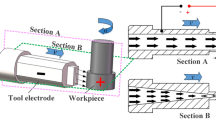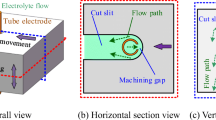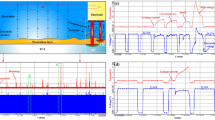Abstract
Electrochemical machining (ECM) is an efficient technique for machining hard-to-cut metallic materials such as titanium alloys. Based on ECM, jet electrochemical machining (jet-ECM) in which electrolyte is continuously ejected from the cathode tool nozzle improves the mass transfer. In jet-ECM, the electrolyte usually forms a flow along the workpiece after the impacting, leading to a weak current density distribution which surrounds the machining region. In jet-ECM of titanium alloys, stray corrosion easily occurs on the un-machined surface around the machining region as a result of the susceptibility of titanium alloys to stray current. In this paper, a method for rapidly obtaining the ideal jet reflection shape by applying an ultra-high current density is proposed. This method effectively separates the reflected electrolyte from the workpiece, thus protecting the un-machined surface from stray corrosion. Simulations with multiple coupled physical fields are established to investigate the interactions among the electric field distribution, flow field distribution, and geometry deformation in jet-ECM. A series of observational experiments are carried out to verify the simulation results. To study the influence of the current density on the machining characteristics, the performance of jet-ECM using current densities from 200 to 600 A/cm2 was discussed in terms of the achievable groove dimensions, material removal rate, current efficiency, and energy efficiency. The results reveal that a proper jet reflection shape can be rapidly formed in jet-ECM by applying an ultra-high current density, and the grooves fabricated in this way are free from stray corrosion and possess shape edges.











Similar content being viewed by others
References
Natsu W, Ikeda T, Kunieda M (2007) Generating complicated surface with electrolyte jet machining. Precis Eng 31(1):33–39. https://doi.org/10.1016/j.precisioneng.2006.02.004
Natsu W, Ooshiro S, Kunieda M (2008) Research on generation of three-dimensional surface with micro-electrolyte jet machining. CIRP J Manuf Sci Tec 1(1):27–34. https://doi.org/10.1016/j.cirpj.2008.06.006
Hackert-Oschätzchen M, Meichsner G, Zeidler H, Zinecker M, Schubert A (2011) Micro machining of different steels with closed electrolytic free jet. AIP Conf Proc 1353:1337–1343. https://doi.org/10.1063/1.3589702
Hackert-Oschätzchen M, Meichsner G, Zinecker M, Martin A, Schubert A (2012) Micro machining with continuous electrolytic free jet. Precis Eng 36(4):612–619. https://doi.org/10.1016/j.precisioneng.2012.05.003
Hackert-Oschätzchen M, Martin A, Meichsner G, Zinecker M, Schubert A (2013) Microstructuring of carbide metals applying jet electrochemical machining. Precis Eng 37(3):621–634. https://doi.org/10.1016/j.precisioneng.2013.01.00
Schubert A, Hackert-Oschätzchen M, Martin A, Winkler S, Kuhn D, Meichsner G, Zeidler H, Edelmann J (2016) Generation of complex surfaces by superimposed multi-dimensional motion in electrochemical machining. Procedia CIRP 42:384–389. https://doi.org/10.1016/j.procir.2016.02.216
Mitchell-Smith J, Speidel A, Gaskell J, Clare AT (2017) Energy distribution modulation by mechanical design for electrochemical jet processing techniques. Int J Mach Tools Manuf 122:32–46. https://doi.org/10.1016/j.ijmachtools.2017.05.005
Mitchell-Smith J, Speidel A, Clare AT (2018) Advancing electrochemical jet methods through manipulation of the angle of address. J Mater Process Technol 255:364–372. https://doi.org/10.1016/j.jmatprotec.2017.12.026
Clare AT, Speidel A, Bisterov I, Jackson-Crisp A, Mitchell-Smith J (2018) Precision enhanced electrochemical jet processing. CIRP Ann-Manuf Techn 67(1):205–208. https://doi.org/10.1016/j.cirp.2018.04.086
Hackert-Oschätzchen M, Meichsner G, Schubert A (2008) Generating micro geometries with air assisted jet electrochemical machining. Proceedings of the 10th Anniversary International Conference of the European Society for Precision Engineering and Nanotechnology 420–424. ISBN: 978–0–553082–5–3.
Wang M, Bao Z, Qiu G, Xu X (2017) Fabrication of micro-dimple arrays by AS-EMM and EMM. Int J Adv Manuf Technol 93(1–4):787–797. https://doi.org/10.1007/s00170-017-0538-0
Guo C, Qian J, Reynaerts D (2017) Electrochemical machining with scanning micro electrochemical flow cell (SMEFC). J Mater Process Technol 247:171–183. https://doi.org/10.1016/j.jmatprotec.2017.04.017
Liu G, Zhang Y, Natsu W (2019) Influence of electrolyte flow mode on characteristics of electrochemical machining with electrolyte suction tool. Int J Mach Tools Manuf 142:66–75. https://doi.org/10.1016/j.ijmachtools.2019.04.010
Wang X, Qu N, Fang X (2019) Reducing stray corrosion in jet electrochemical milling by adjusting the jet shape. J Mater Process Technol 264:240–248. https://doi.org/10.1016/j.jmatprotec.2018.09.017
Liu Y, Qu N (2020) Experimental and numerical investigations of reducing stray corrosion and improving surface smooth in macro electrolyte jet machining titanium alloys. J Electrochem Soc 167:083502. https://doi.org/10.1149/1945-7111/ab88ba
Kawanaka T, Kunieda M (2015) Mirror-like finishing by electrolyte jet machining. CIRP Ann-Manuf Techn 64(1):237–240. https://doi.org/10.1016/j.cirp.2015.04.029
Wang Y, Qu N (2019) Effect of breakdown behavior of passive films on the electrochemical jet milling of titanium alloy TC4 in sodium nitrate solution. Int J Electrochem Sci 14(2):1116–1131. https://doi.org/10.20964/2019.02.05
Funding
This work was supported by Defense Industrial Technology Development Program (Grant No. JCKY2021605B003), Science Center for Gas Turbine Project (P2022-A-IV-002-001), National Natural Science Foundation of China for Creative Research Groups (Grant No. 51921003), and Postgraduate Research & Practice Innovation Program of Jiangsu Province (Grant No. KYCX20_0181).
Author information
Authors and Affiliations
Contributions
Huanghai Kong: conceptualization, methodology, investigation, data curation, experiment, writing-original draft. Ningsong Qu: review and editing, supervision, funding acquisition.
Corresponding author
Ethics declarations
Competing interests
The authors declare no competing interests.
Additional information
Publisher's Note
Springer Nature remains neutral with regard to jurisdictional claims in published maps and institutional affiliations.
Rights and permissions
Springer Nature or its licensor (e.g. a society or other partner) holds exclusive rights to this article under a publishing agreement with the author(s) or other rightsholder(s); author self-archiving of the accepted manuscript version of this article is solely governed by the terms of such publishing agreement and applicable law.
About this article
Cite this article
Kong, H., Qu, N. Jet electrochemical milling of Ti-6Al-4 V alloy with ultra-high current density. Int J Adv Manuf Technol 129, 4091–4100 (2023). https://doi.org/10.1007/s00170-023-12607-3
Received:
Accepted:
Published:
Issue Date:
DOI: https://doi.org/10.1007/s00170-023-12607-3




